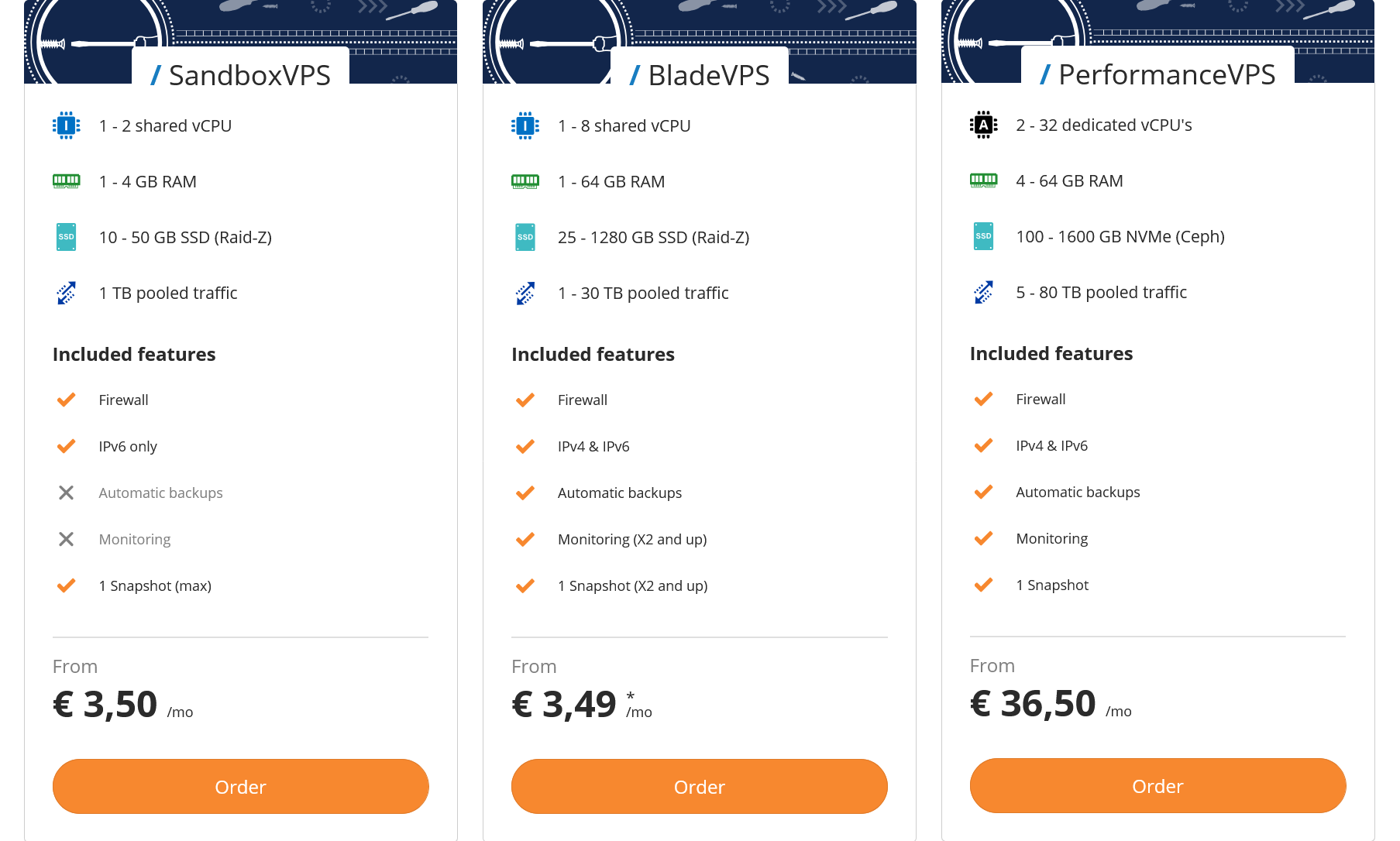Suppose you are looking for a virtual machine. At TransIP, you have a choice of three different VPS platforms: the BladeVPS, PerformanceVPS, and SandboxVPS. Each platform also has different sizes. But... which type of VPS and which size is useful for your use case? In this article, we answer these questions.
The differences between a BladeVPS, PerformanceVPS, and SandboxVPS
Before we dive into the choice between a type and size of VPS, it is important to consider the differences between the types of VPS. This boils down to two points: hardware specifications and available features. In an overview, it looks like this:

Hardware:
The different types of VPSs distinguish themselves in terms of hardware, in addition to the minimum and maximum amount of hardware, on a few more points:
- SandboxVPSs and BladeVPSs use Intel CPUs, PerformanceVPSs use AMD CPUs.
- SandboxVPSs and BladeVPSs use shared CPUs, and PerformanceVPSs use dedicated CPUs. The difference between shared and dedicated CPUs is explained in this article.
- All VPS types use NVMe, but the PerformanceVPS has a much higher IOPS capacity.
- The storage servers that host the data of SandboxVPSs and BladeVPSs use ZFS. For PerformanceVPSs, we use CEPH. Simply put, both techniques store data redundantly, but CEPH also spreads the data across multiple servers, reducing the chance of downtime (we guarantee 99.9% uptime for both).
Features:
- SandboxVPSs exclusively use IPv6, BladeVPSs and PerformanceVPSs support IPv4 and IPv6.
- We make a backup every 4-6 hours (maximum 9) of BladeVPSs and PerformanceVPSs. SandboxVPSs come without backups.
- You can monitor the availability of a BladeVPS and PerformanceVPS, but not a SandboxVPS.
Choosing a VPS type
The choice for a type of VPS mainly depends on the use case. What will you use the VPS for? In this paragraph, we list recommended use cases for the different types of VPSs.
A snapshot of one type of VPS (e.g., a BladeVPS) can be restored on another type of VPS (e.g., a PerformanceVPS), provided the maximum available disk space of the original VPS and the new VPS match.
SandboxVPS: The SandboxVPS is designed as an accessible and affordable test and development VPS. For developing and testing applications, the SandboxVPS is ideal. Note that for testing under production load, a larger VPS may be needed.
BladeVPS: The all-around server with an ideal balance between price and quality. A BladeVPS is excellent for, for example:
- Small to medium websites
- Blogs
- Small databases (up to +- 2500 IOPS / 500MB/s)
- Larger test servers
- Mail servers
- Plex media servers
- Teamspeak servers
- Hosting of repositories
- Forums
- Small gaming server (e.g. Minecraft, VRising)
- Windows Server Active Directory,
- (smaller) MS Exchange Server,
- Windows SMB Server
- Windows Server RD Gateway, RD Licensing, RD Web Access, RD Connection Broker.
PerformanceVPS: When you are looking for the fastest of the fastest, the PerformanceVPS is the best answer. A PerformanceVPS is suitable for, among others:
- Large websites
- Processor-intensive tasks such as video encoding
- E-commerce websites (e.g., Magento)
- Medium to large database servers
- Larger video streaming platforms
- Data analysis and processing
- Critical business applications, with intense Java use
- Remote Desktop work / Windows Server RD Session Hosts (the performance is almost indistinguishable from a physical computer)
- MS SQL servers
- (large) MS Exchange Server
Choosing a VPS size
The size of the VPS is mainly determined by the workload. This may be the hardest to determine in advance. How heavily will you load the VPS? For example, will the websites you host together get 100 or 10000 concurrent visitors? You can't always answer this well in advance, so it's important to realize that you can always upgrade a VPS to a larger VPS (unless you already have the largest one, of course). We recommend starting with a smaller VPS and upgrading it later as your project grows. To illustrate, we list some examples and guidelines:
Use case where one x4 BladeVPS suffices:
- Linux mail server
- Small database server
- Plex media server (up to 3 simultaneous users depending on the equipment on which media is played)
- A Windows Active Directory server and RD Connection Broker combined
- A Windows RD Licensing Server, RD Web Access, RD Gateway, SMB File Server combined
Use case where one C2 PerformanceVPS suffices:
- Medium database server
- A Remote Desktop server for one or two people with a small workload.
- Hosting (up to) a dozen Magento websites.
Guideline for size for:
- Remote Desktop Servers: +- 4 users per virtual CPU core, where you can accommodate more users per core if you use larger servers (with 8 or more cores) because this is better able to handle a spike in resource usage by one or two users. For detailed advice, see also this guide from Microsoft (under multi-session).
- WordPress hosting: 256MB RAM per website is sufficient, especially with a larger server. This also depends on how intensively the hosted websites are used. For websites with low numbers of visitors (a few dozen per day), you can even assume +-8 websites per GB RAM of your server.
- E-commerce websites: A good guideline for e-commerce websites is that you need about 512MB - 1GB RAM per website. If you use a larger server (e.g., 16GB RAM), you can assume a larger number of websites (512MB per site) because not all sites use resources equally at all times, giving you some flexibility.
This brings us to the end of this article about choosing a VPS. If you are still unsure about your choice or have a unique use case for which you seek further advice, do not hesitate to send us a message via the TransIP control panel.




